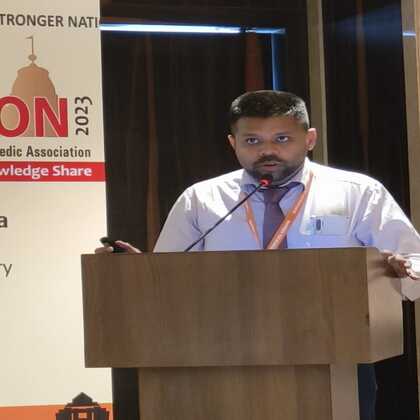Cervical Spondylitis Care: Understanding and Managing the Symptoms and Treatment Options
Know more about cervical spondylitis care, including its symptoms, treatment options, home remedies, and long-term management for a better quality of life.

Written by
Last updated on 3rd Jul, 2025
Understanding Cervical Spondylitis
Cervical spondylitis and lumbar spondylosis are considered the two common forms of spondylitis. Cervical spondylitis occurs when the bones, cartilage, ligaments, and bones in the neck region start to wear and tear with or without age. Many decades ago, cervical spondylitis and spondylosis were associated with old age. However, with changes in the current lifestyle of the present generation, spondylitis, and spondylosis can happen in any age group. Cervical spondylitis or spondylosis is also called cervical osteoarthritis or degenerative osteoarthritis. With age and time, the symptoms of the same can increase. Without proper and timely treatment, cervical spondylitis might even make walking a challenge.
Few Early Signs of Cervical Spondylitis
Below are a few symptoms of cervical spondylitis to watch out for:
Neck pain or stiffness after prolonged inactivity or waking up in the morning.
Numbness or tingling in the arms, hands, or shoulders due to nerve compression.
Muscle weakness in the upper limbs may indicate more severe nerve involvement.
Frequent headaches that may originate from the base of the skull and extend toward the forehead.
Difficulty moving the neck and reduced flexibility that may lead to discomfort while performing daily tasks.
Unusual grinding or popping sounds when moving the neck, indicating wear and tear of vertebrae.
A person experiencing the symptoms mentioned above may want to seek medical attention.
Causes of Cervical Spondylitis
The primary cause of cervical spondylitis is ageing, which may lead to degeneration of the cervical spine. However, other factors contributing to its onset may include the following:
Bone Spurs: As the body tries to repair the damage, extra bone growths may form, which can press on nerves and the spinal cord.
Genetic Predisposition: A family history of cervical spondylitis may increase susceptibility, making a few individuals more prone to developing the condition at an earlier age.
Herniated Discs: Over time, the spinal discs may lose their cushioning, leading to nerve compression and associated pain.
Poor Posture and Repetitive Strain: Prolonged use of mobile phones and laptops can strain the neck, leading to early wear and tear.
Lack of Physical Activity: A sedentary lifestyle may weaken the muscles supporting the cervical spine, increasing strain on vertebrae and discs.
Previous Neck Injuries: Trauma such as fractures or whiplash can accelerate spinal degeneration.
Consult Top Orthopaedician
Diagnosis of Cervical Spondylitis
There are a few ways one can choose to diagnose cervical spondylitis, such as:
Imaging Tests
Imaging tests include X-rays, CT scans and MRIs.
X-rays: These help reveal bone abnormalities such as bone spurs, disc degeneration and misalignment of vertebrae.
CT Scans: These offer cross-sectional images to understand bone structures and potential nerve impingements better.
MRI Scans: These provide detailed images of soft tissues, including nerves, discs and the spinal cord, to assess compression or inflammation.
Physical Examination
Doctors may want an individual to undergo a physical examination to diagnose cervical spondylitis.
A healthcare professional may assess an individual’s neck’s range of motion, muscle strength and reflexes.
The doctor may inquire about their symptoms and lifestyle habits to identify contributing factors and medical history.
The doctor may perform specific tests, such as Spurling’s test, to check nerve compression.
Risk Factors of Cervical Spondylitis
Below-mentioned are a few risk factors that could be associated with cervical spondylitis:
Gender and Age
Cervical spondylitis risks may increase with age, particularly after 40 years. More prone to the condition are men than women, due to differences in physical activity levels and occupational stressors.
Trauma or Injuries
An individual having a history of neck injuries or trauma can predispose them to early degenerative changes in the cervical spine. For instance, whiplash injuries that may be sustained in a car accident may lead to chronic issues if not appropriately managed.
Lifestyle and Occupational Risks
Individuals who work in job environments involving more neck movements, heavy lifting or prolonged use of mobile devices and laptops may increase the risk of cervical spondylitis. A phenomenon called the “tech neck” may also be caused by prolonged usage of devices. Professions like desk workers, drivers, and assembly line workers may be more prone to being affected by the condition. Poor sleeping posture or use of improper pillows that do not support the cervical spine may be vulnerable.
Who is More Likely to Develop Cervical Spondylitis?
There are a few individuals who may be more likely to develop cervical spondylitis like:
Those living a sedentary lifestyle, particularly the ones who work long hours at a desk.
Those with a family history of spinal conditions may inherit weaker spinal structures.
Those who have experienced neck injuries in the past, such as from accidents or sports.
Those who are over 50 years old can be at greater risk due to natural spinal degeneration.
Treatment Options
A few treatment options for cervical spondylitis can be:
Physical Therapy and Exercises
Physical therapy includes:
Exercises: Strengthening exercises for the neck and shoulders to provide better support for the cervical spine.
Cold and Heat Therapy: This helps in pain relief and inflammation reduction.
Ultrasound Therapy: It helps in improving blood flow and reducing stiffness.
Postural Training: This helps reduce strain caused by poor ergonomic habits.
Medications
Medications that can help with cervical spondylitis include:
Muscle Relaxants: These help reduce muscle stiffness and spasms, which improve mobility.
Antidepressants: These are sometimes prescribed to help with chronic pain management.
Corticosteroid Injections: These provide temporary relief for severe pain and inflammation.
Pain Relievers: NSAIDs (ibuprofen, naproxen) may help in managing pain and inflammation.
Home Remedies and Lifestyle Changes
People with signs of cervical spondylitis must follow a few home remedies and make necessary lifestyle changes to better the condition.
Stretches and Exercises
Neck Stretches: Tilting the head slowly from side to side and forward to backward can improve flexibility.
Chin Tucks: Strengthening neck muscles and improving posture can help reduce strain on the vertebrae.
Shoulder Rolls: This helps reduce tension in the upper back and shoulders.
Ergonomics Adjustments
Proper Postures: Maintain a proper posture with back support and feet flat on the floor.
Supportive Pillows: Use supportive pillows while sleeping to keep the neck in a neutral position.
Laptop Screen Position: Position screens at eye level to prevent excessive neck strain.
Surgical Interventions
Surgery may be recommended in severe cases where nerve compression leads to loss of function, particularly when the spinal cord is significantly affected, leading to mobility issues. If conservative treatments fail to provide relief, surgical intervention may be necessary. Common procedures include cervical laminectomy, cervical fusion or discectomy.
Alternative Therapies
A few alternate therapies may include:
Yoga and Pilates: May help promote flexibility and strengthen neck-supporting muscles.
Acupuncture: May help in alleviating pain by stimulating specific pressure points.
Massage Therapy: May help in relieving muscle tension and improving circulation.
Chiropractic Care: Chiropractic adjustments help improve spinal alignment and relieve nerve compression. However, they should only be performed by qualified professionals.
Long-Term Management
It is essential to have regular follow-ups with a healthcare provider to help assess condition progression and adjust treatment plans accordingly. Regular check-ups help prevent complications through early intervention. It can help individuals modify medication or therapy in a timely manner and track the effectiveness of treatments.
Conclusion
Cervical Spondylitis can be managed effectively with early diagnosis and proper treatments. Delaying medical interventions may lead to chronic pain and neurological complications. Physical therapy, exercises, lifestyle changes, and alternative treatments can help individuals lead comfortable lives despite cervical spondylitis.
Consult Top Orthopaedician
Consult Top Orthopaedician

Dr. Anil Pradeep Jadhav
Orthopaedician
23 Years • MBBS MS (Ortho)
Nashik
Apollo Hospitals Nashik, Nashik
(25+ Patients)
Dr. Anil Sharma
Orthopaedician
42 Years • MBBS, MS Orthopedics
New Delhi
AAKASH MEDSQUARE, New Delhi
Dr. Vamsi Krishna Reddy
Orthopaedician
6 Years • MBBS, M.S.Orthopaedics
Guntur
Sri Krishna Orthopedic And Dental Hospital, Guntur

Dr. Manoj Dinkar
Orthopaedician
15 Years • MBBS, Dip (Orthopaedics)
New Delhi
THE DOCTORS NESST, New Delhi

Dr. Mriganka Ghosh
Orthopaedician
11 Years • MD (Physician), DNB (Orthopaedics)
Howrah
Dr Mriganka Mouli Ghosh, Howrah
Consult Top Orthopaedician

Dr. Anil Pradeep Jadhav
Orthopaedician
23 Years • MBBS MS (Ortho)
Nashik
Apollo Hospitals Nashik, Nashik
(25+ Patients)
Dr. Anil Sharma
Orthopaedician
42 Years • MBBS, MS Orthopedics
New Delhi
AAKASH MEDSQUARE, New Delhi
Dr. Vamsi Krishna Reddy
Orthopaedician
6 Years • MBBS, M.S.Orthopaedics
Guntur
Sri Krishna Orthopedic And Dental Hospital, Guntur

Dr. Manoj Dinkar
Orthopaedician
15 Years • MBBS, Dip (Orthopaedics)
New Delhi
THE DOCTORS NESST, New Delhi

Dr. Mriganka Ghosh
Orthopaedician
11 Years • MD (Physician), DNB (Orthopaedics)
Howrah
Dr Mriganka Mouli Ghosh, Howrah
